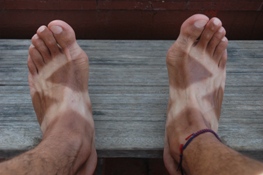Since gaining independence from French colonial rule in the 1950's, Cambodia saw two decades of stability until a military coup deposed the president. While in exile, and under Chinese pressure, the former President put his support and power behind the rebels of the Khmer Rouge. At the same time, Cambodia got sucked into the Vietnam conflict. Bitter in-fighting culminated in the fall of the capital, Phnom Penh, to the Khmer Rouge in 1975.
Led by the Maoist lunatic Pol Pot, the Khmer Rouge went about trying to transform Cambodia into an agrarian society of homogeneity. To achieve this "idyllic" society where no one possessed any form of distinction, Pol Pot went about systematically "cleansing" the country of anyone not fitting into his vision. If you were educated (teachers, doctors, writers), spoke a foreign language, or even wore glasses... it's likely that the Khmer Rouge relocated, detained, tortured and killed you. From 1975 to 1979, when the Vietnamese over threw the Khmer Rouge, some 2 million Cambodians died at the hands of Pol Pot. That's genocide folks.
...
Cambodia today bears the scars of the atrocities committed less than 30 years ago. Nowhere is it more evident than in Phnom Penh. The S-21 (Security Prison No. 21), now a museum, was the largest detention and torture center in the country. 20,000 Cambodians went through S-21... only 7 lived... the majority were executed and buried in the mass graves of the nearby Killing Fields.
In the museum, wall after wall of chilling photos depict the faces of those detained at S-21. These mug-shots, so many of them children, are so vivid you want to look away but you can't. The faces burn with emotion... some are frightened, some are holding onto pride, others are confused, and others just say "fuck you" to the prison guards taking their photo. The former prison cells are still littered with torture devices and steel shackles. How did this happen?
Only a few miles outside of Phnom Penh, the Killing Fields are the disgraceful tomb for the prisoners of S-21. The 129 mass graves, most of which have been disinterred, are a surreal place to walk around. The deep pits of earth still contain shreds of clothing, shards of bone, and scattered teeth. At the center of the area is a memorial stupa containing shelf after shelf of the victims' skulls. The pain still seems to register on their faces.
...
Why go to see such things, you may ask? I ask myself the same thing. My answer is the same one that took me to Hiroshima while I was travelling in Japan. It's not sensationalism, or a morbid curiosity. It's important, I think, not to side-step the grotesque, brutal, and shameful acts that man is capable of. Unless you comprehend the full extent of the atrocities man can inflict on his peers, you won't fully value the love and kindness that you are fortunate to have in your life.








No comments:
Post a Comment